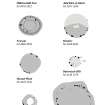Scheduled Maintenance
Please be advised that this website will undergo scheduled maintenance on the following dates: •
Tuesday 3rd December 11:00-15:00
During these times, some services may be temporarily unavailable. We apologise for any inconvenience this may cause.
'The Chapel O' Sink'
Cairn (Period Unassigned)
Site Name 'The Chapel O' Sink'
Classification Cairn (Period Unassigned)
Alternative Name(s) Chapel Of Sink; Westerton Farm; Boghead Wood
Canmore ID 18681
Site Number NJ71NW 4
NGR NJ 7060 1895
Datum OSGB36 - NGR
Permalink http://canmore.org.uk/site/18681
- Council Aberdeenshire
- Parish Chapel Of Garioch
- Former Region Grampian
- Former District Gordon
- Former County Aberdeenshire
NJ71NW 4 7060 1895
(NJ 7060 1895) Chapel o' Sink (NAT)
Stone Circle (NR)
OS 6" map, (1959)
See also NJ71NW 28.
The name 'Chapel o' Sink' is said to derive from an attempt to build a chapel here. Each night the walls sank out of sight and had to be built again each morning, so the work was abandoned.
F R Coles 1901.
The remains of a stone circle 45' (13.7m) in diameter, known as the Chapel o' Sink, are situated on the slope of the ridge, at the back of Westerton farm. The majority of the existing stones are only 1' (0.3m) high, and are apparently from an elliptical, or circular inner setting, which was once part of a larger circle of pillar stones. An old cart-track passing along one side has displaced several stones.
J Ritchie 1917.
The remains consist of a near-circular uneven stony area about 16.5m NW-SE by 15.0m NE-SW and 0.5m maximum height edged in the N, W, and SW arcs by several kerb-stones. In the N, five of these stones are contiguous, but in the W they are intermittently placed though a bedding trench can be seen between them where stones have been removed. The stones in the SW, 0.6m high, are noticeably larger than those in the N, 0.4m high. In the SE the edge of the circle is not clear.
There is no firm evidence to support Ritchie's (1917) implication that the site is the remains of a recumbent stone circle, though there is a possibility that the remains are the remnants of the internal cairn of such a monument. However, unless further evidence can be procured, the site can only be classified as a robbed cairn. The name 'Chapel o' Sink' is still known locally.
Revised at 1/2500.
Visited by OS (ISS), 24 July 1973.
Burl (1973) lists this as a possible recumbent stone circle.
H A W Burl 1973.
No change to previous field report.
Revised at 1/2500.
Visited by OS (NKB) 19 August 1976.
The remains of this robbed cairn are situated in coniferous woodland, and comprise a discontinuous ring of at least twenty-seven kerbstones 14.7m in diameter overall. The best-preserved arc of the kerb is on the NE, where there are five contiguous boulders. The largest of the kerbstones are situated on the SW and are up to 0.6m in height. Little cairn material survives within the kerb, where the surface of the ground is rough and uneven, but at the centre there is a concentration of stones forming a mound about 5m in diameter and 0.3m high.
Visited by RCAHMS (JRS, IF), 25 July 1996.
Scheduled as 'Chapel o' Sink, cairn...'
Information from Historic Scotland, scheduling document dated 4 March 2008.
Publication Account (2011)
This robbed cairn, which lies in a plantation of conifers on the rising ground behind Westerton, measures about 14.7m in diameter over a kerb of slabs and small boulders, of which about thirteen remain in place. Neatly built, the kerb is graded in height, the tallest of its stones standing about 0.6m high on the south-west. In this respect the cairn resembles some of those recorded within recumbent stone circles, though in this case there is no evidence that the kerb was ever adapted to incorporate a recumbent, nor that there was once a surrounding circle of orthostats. The cairn was already robbed by 1867 and is described in the Name Book as ‘a circle of standing stones of no great height nor size’ (Aberdeenshire, No. 13, p 102). The suggestion that this is the remains of a recumbent stone circle was first made by James Ritchie (1917, 40–1), and from that source it has found its way into later lists as a probable or possible example (Burl 1970, 79; 1976a, 350, Abn 26; 2000, 420, Abn 26; Ruggles 1984, 60; 1999, 187, no. 64). It was Ritchie’s contention that the Ark Stone, a block incorporated into the dyke separating the plantation from the fields about 100m to the north-north-west (NJ 7058 1908; NJ71NW 28), was the recumbent robbed from the circle, though neither its size nor its shape would have lent itself to such a use. Indeed, there is no reason to believe that the Ark Stone is anything more than an erratic, lying where it was dumped by ice thousands of years ago. It was a well-known local landmark in the days before the ground was enclosed and served as a marker on the march between the estates of Monymusk and Balquhain (Name Book, Aberdeenshire, No. 13, p 104). The name of the cairn, Chapel o’ Sink, carries with it a similar folklore to the Sunken Kirk (NJ52NW 6), in which building work on a chapel by day disappeared by night (ibid, p 102; Ritchie 1917, 40–1; 1926, 306).




































